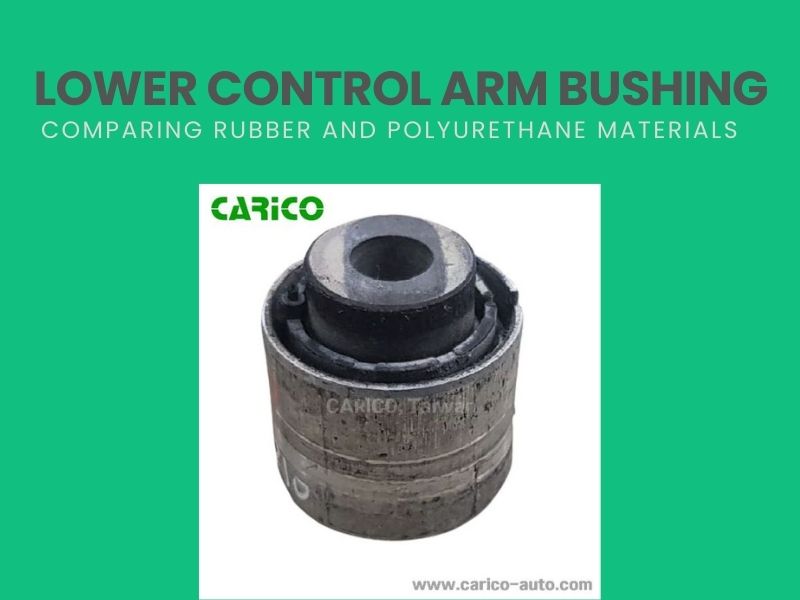Lower Control Arm Bushing: Comparing Rubber and Polyurethane Materials

The lower control arm bushing is a small but crucial component in your vehicle’s suspension system. It provides cushioning and reduces vibration by absorbing shocks between the vehicle frame and control arm, maintaining alignment and offering a comfortable driving experience. When choosing new bushings, the most common materials you'll encounter are rubber and polyurethane. Each material offers distinct advantages and disadvantages, depending on your driving needs and conditions.
With extensive expertise in suspension components, Carico recognizes the importance of selecting the right lower control arm bushings for enhanced vehicle safety, performance, and comfort. In this article, we'll explore the key differences between rubber and polyurethane lower control arm bushings, guiding you toward making the best choice based on your individual driving needs.
Rubber Lower Control Arm Bushings
Rubber is the most common and widely used material in OEM (Original Equipment Manufacturer) bushings. Its popularity stems from several beneficial properties:
- Excellent Vibration Absorption: Rubber naturally absorbs shocks and vibrations, ensuring a comfortable and quiet ride.
- Affordable Cost: Generally less expensive and readily available as a standard replacement part.
- Factory Comfort and Noise Reduction: Provides a smooth driving experience similar to the original ride quality of your vehicle.
- Ease of Installation: Designed specifically for your vehicle, rubber bushings typically fit perfectly without modification.
Drawbacks of Rubber Bushings:
- Shorter Lifespan: Susceptible to deterioration from exposure to heat, oil, or harsh weather conditions.
- Reduced Performance: Limited stiffness can result in decreased handling performance in demanding driving conditions.
Polyurethane Lower Control Arm Bushings
Polyurethane, a synthetic material, is often chosen for performance upgrades due to its robust properties. Common in aftermarket upgrades, polyurethane bushings offer these key advantages:
- Enhanced Performance and Handling: Polyurethane is stiffer, providing better control and responsiveness during driving, especially when cornering.
- Increased Durability and Longevity: Highly resistant to environmental factors like oil, heat, and extreme temperatures, leading to a significantly longer lifespan compared to rubber.
- Customization and Performance Tuning: Available in varying degrees of stiffness, allowing drivers to select bushings tailored specifically to their driving style or performance requirements.
- Consistent Performance: Retains its structural integrity and performance capabilities over extended periods and under challenging conditions.
Drawbacks of Polyurethane Bushings:
- Higher Initial Cost: Usually more expensive than rubber due to advanced manufacturing processes.
- Increased Vibration Transmission: Stiffer material may transmit more road vibration to the vehicle’s interior, resulting in a slightly rougher ride.
- Periodic Lubrication Required: May require occasional lubrication to avoid squeaking or excessive noise during operation.
Choosing the Right Material for Your Lower Control Arm Bushing
The decision between rubber and polyurethane largely depends on your specific needs and driving conditions:
- Daily Commuting and Comfort: If your main priority is ride comfort, quietness, and a smooth, factory-like driving experience, rubber bushings are an ideal choice.
- Performance and Handling Enthusiasts: Drivers who value improved handling, cornering, or participate in racing and performance driving scenarios should strongly consider upgrading to polyurethane bushings.
- Vehicle Longevity and Maintenance: Polyurethane's resistance to environmental stressors and longer lifespan makes it attractive if you’re aiming for less frequent replacements, despite the slightly higher initial investment.
Maintenance Tips for Both Types of Bushings
Regardless of the material you choose, proper care will extend the life of your bushings:
- Regular Inspections: Check for visible cracks, excessive wear, or deformation during routine maintenance.
- Lubrication (For Polyurethane): Apply appropriate grease periodically to prevent noise and ensure smooth operation.
- Prompt Replacement: Replace worn or damaged bushings promptly to prevent further suspension system issues.
Conclusion
Understanding the differences between rubber and polyurethane lower control arm bushings can significantly impact your vehicle's comfort, performance, and long-term maintenance costs. Consider your driving habits, vehicle requirements, budget, and personal preferences to make an informed choice.
At Carico, we offer high-quality lower control arm bushings designed to meet diverse vehicle needs. Whether you prefer traditional rubber for everyday comfort or high-performance polyurethane, Carico provides reliable solutions tailored to your specific requirements.
Contact us today to find the perfect lower control arm bushing for your vehicle, and experience the difference in comfort and handling firsthand.

